by Tom Gaylord
Writing as B.B. Pelletier
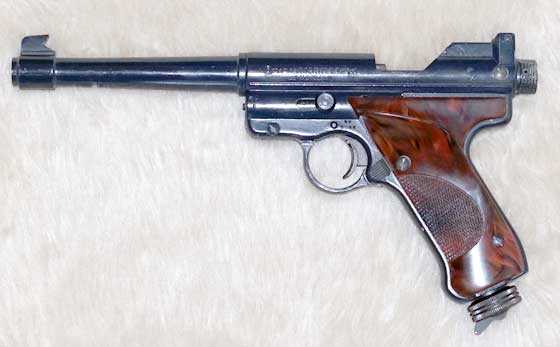
Crosman Mark I target pistol.
This report covers:
- The test
- Hobby pellets
- Crosman Premiers
- RWS Superpoint
- Discussion
- Summary
Today we look at the accuracy of the Crosman Mark I Target pistol. After adjusting the trigger in Part two, I feel confident it won’t let me down.
The test
I put in a fresh 12-gram CO2 cartridge. We learned in Part 2 that there are around 45 full-power shots in a cartridge and I plan to shoot less than that in today’s test. I will shoot a 5-shot group on high power and a second 5-shot group on low power with each pellet. That’s 10 shots per pellet times 3 pellets is a total of 30 shots. The range is 10 meters and the gun is rested directly on a sandbag. Let’s go.
Hobby pellets
The first group was shot with RWS Hobby pellets. The gun’s power was set on high. Five Hobbys made a very vertical 0.733-inch group.
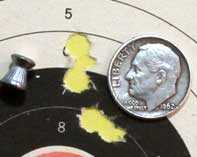
On high power the Mark I put 5 Hobbys into 0.733-inches at 10 meters. Not a bad group for an air pistol.
On low power, 5 of the same Hobby pellets went into 0.754-inches at the same 10 meters. This group isn’t quite as vertical and the point of impact dropped 1.8 inches.
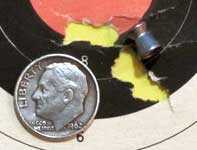
On low power the Mark I put 5 Hobbys into 0.754-inches at 10 meters.
Wadcutter pellets like Hobbys are easiest to see when they tear holes in target paper. Domes, however, can be more accurate. Let’s try some.
Crosman Premiers
The next pellet I tried was the venerable Crosman Premier. When they came to market in the mid-’90s airgunners suddenly realized that their vintage Crosman pellet guns were a lot more accurate than they thought. The gun that surprised everyone the most was the 160 rifle that went from being a plinker to a real target rifle. But the Mark I and II pistols also benefitted. Let’s see.
On high power the Mark I put 5 Premier pellets into a 0.442-inch group at 10 meters. It’s the smallest group of the test and can be covered by a CR2032 button battery or by an American penny. That’s some shootin’ and it makes me quite proud of this old air pistol.
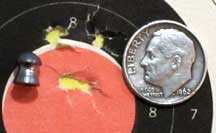
Five Crosman Premiers shot on high power went into 0.442-inches at 10 meters. That’s the smallest group of the test.
On low power the Premier group dropped 2.4 inches and opened to 1.025-inches for 5 shots. Notice that both these groups are centered on the bull, where both Hobby groups were slightly right of center.
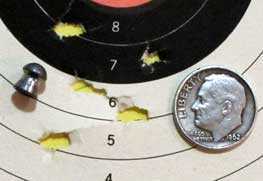
On low power the Premier pellets opened to this 1.025-inch group.
RWS Superpoint
The last pellet I tested was the RWS Superpoint. I had no idea how these would do because I don’t think I have ever shot them in a Mark I before. Pointed pellets don’t usually shoot accurately, although I have reported on some exceptions in the past. On high power 5 pellets went into 1.537-inches at 10 meters. It is the largest group of the test, so obviously Superpoints are not right for the Mark I Target.
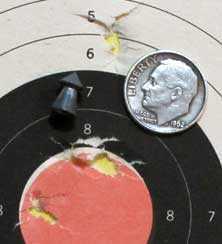
On high power 5 RWS Superpoint pellets went into 1.537-inches at 10 meters. This is the largest group of the test.
I thought, after seeing this group, that the low power group would be even larger, but it wasn’t. On low power the Mark I Target put 5 Superpoint pellets into a 1.23-inch group at 10 meters. This group is centered about 2.3 inches below the high-power group.
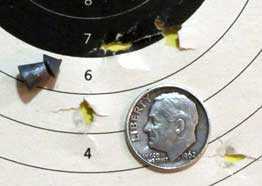
On low power the Mark I put 5 Superpoints into 1.23-inches at 10 meters.
Discussion
I am satisfied with the performance of the pistol. It’s accurate — especially with Crosman Premiers. And the trigger is very sweet. This series makes me want to get a .177-caliber Mark II to go along with this one.
The power of the gun is fine and I’m getting a reasonable number of shots for the power that’s available. This is an airgun I don’t shoot all the time but I never want to get rid of it. It’s nice to know I can shoot it when I want to.
Summary
The Crosman Mark I Target pistol surprised me with more power and a better trigger than I had expected. How nice to know this vintage airgun still has what it takes!
Postscript
I went to a good gun show last Saturday. It was the first show I have been to in a long time. I picked up a Crosman 1377 that I plan to test for you. I also bought an old rimfire Flobert rifle of some unknown caliber around .30. I don’t know what I will do with it yet, but we shall see.

B.B.,
Good to see it can still cook. It is a beauty just to look at and must feel great in hand.
Good Day to one and all,……….. Chris
BB,
“How nice to know this vintage airgun still has what it takes!”
My sentiments exactly. But of course you know that, don’t you? 😉
RR,
We’re aware of your fondness for vintage airguns, but does it extend to any of the vintage Crosman CO2 guns?
Derrick
Derrick,
Not really. The main reason is here in the hills of Virginia it is a bit too cool most of the time to use CO2 as a propellant. Having said that, I am in the process of trying to restore a Daisy Power Line 45 to working order. It was given to me a few years back by my brother-in-law and leaks real bad. I tried the Pellgun oil trick, but that did not work. I just replaced the cartridge seal, but it still leaks. I am going to have to replace other valve seals and see what happens.
Now, if someone was to send me a Gifford to live at RRHFWA I would jump into CO2 with both feet.
😉
RidgeRunner,
I saw a Giffard on a live auction website a couple weeks ago. I forget what the opening bid was to be, but it was one sweet-looking air gun.
Vintage, golden-age Crosmans pose a problem in cold weather, it’s true. New CO2 pistols with magazines that combine BBs with the CO2 cartridge have potential in colder weather if you have a spare mag kept warm in an interior coat pocket. I have shot a 1911 style CO2 replica in 10 degree weather. I shot only about 36 shots, but it was fun. I swapped magazines back and forth every six shots, each time quickly putting the cold one inside my coat, against my body. That was a couple years ago.
I recall one of the reasons I did it was to see if my idea for doing it would work. It mostly did. The last six or so shots in each magazine sounded slower than the others, but they still had enough zip to operate the slide. (At that point my hands and ears were ready to back inside, too.)
Shooting a soup can across the surface of the snow is a treat.
Michael
Michael,
Those Giffards went for lotsa money! I think $4,000 and up. You can get a shooter for around $2,000 or just a little more these days.
B.B.
BB,
I would have to shoot mine. I would not be able to stand it if I couldn’t.
B.B.,
Those prices are about 25 percent above what I would have guessed. Just amazing air guns. Plus, it is not as though new ones are being made. What is out there now is all that will ever be out there.
Unless, in the dark recesses of an old warehouse in New Jersey a few old, factory-sealed boxes are opened and lo and behold . . . ;^)
Michael
Michael,
Every Giffard I have seen, if not in pristine shape was at least still a work of beauty in my eyes. At several airguns shows I have been to there was an elderly gentleman with a small Giffard pistol for sale. He was wanting $3500 for it. Like I said, I would really like to have one but…
RR,
They have this aerodynamic and elegant appearance, a work of art.
Michael
Michael,
Indeed. So much of the Victorian era combined elegance with function.
RidgeRunner
I have one of those Daisys. Well I think mine may say 4500 on it, I can’t remember, but I read where they were one in the same. Thinking about the leak, I see you tried Pellgun oil, but did you try ATF stop leak? I know it brought one of my Daisy 200’s back to life.
Good luck
Doc
Doc,
No, I have not. I picked up a few O-rings to try today. I will fool with it some to see what I can do. I enjoy opening them up and checking out how they function. I may try a little stop leak for giggles.
BB
Good shooting. Are the Crosman Premier pellets the ones that come 1250 in a brown box?
Deck
A 30 cal. rimfire;I’m curious!
Rk,
Almost all of the original cartridges were rimfire or pinfire. The original Henry was a .44 rimfire and I believe the Spencer was a .41 rimfire.
The pinfire did not last long and is VERY rare.
BB
The .30 caliber rimfire is interesting.
And a 1377 to test. What brought that on?
GF1,
The .30 caliber rimfire is more likely a .32 or 8mm. The 1377 I bought because it was an older one and because of a low price.
B.B.
BB
Well that sounds like a good reason to buy another gun. 🙂
But yep looking forward to what you wring out of the 1377.
And ok will be watching how your big bore rimfire report goes. As it goes I’m interested in the accuracy. And why rimfire. Didn’t they think about the reloadable cartridges yet when they made the big bore rimfire.
GF1,
To answer your question about why rimfire you need to know a lot more about the Flobert action.
B.B.
BB
I’ll be watching for the report.
But I guess those cartridges are hard to find now days.
Are they a reloadable rimfire round?
Guess I need to search them and see what they are about.
GF1,
Never heard of a reloadable rimfire.
B.B.
BB
That’s why I asked.
Thought maybe they was one of those lost in time rounds.
Will be waiting to see.
GF1,
What you do is convert the firing pin to fire centerfire and then find a cartridge that will fit the chamber.
B.B.
BB
I would like to see how that’s done. Sounds like fun to me.
GF1,
It’s being done by a knifemaker friend of mine. I gave the gun to him. He will let me see and document it when he does something with it.
B.B.
BB
I’ll be looking forward to seeing that. I’m sure that will be a interesting report.
GF1,
A few enterprising handloaders did indeed reload .22 rimfires during WWII when ammuntion was almost impossible to find. It is not easy since you must mix up your own priming mixture for starters. Not practical unless you are really desperate.
Paul in Liberty County
Paul
Thanks for the info.
GF1,
This is what I told Rk.
Almost all of the original cartridges were rimfire or pinfire. The original Henry was a .44 rimfire and I believe the Spencer was a .41 rimfire.
The pinfire did not last long and is VERY rare.
Centerfire came along mostly after the War of Northern Aggression. It is more expensive to make. The rimfires continued along for a good bit and then mostly faded out as the centerfire became more prevalent toward the beginning of the 1900’s.
RR
Yep and I was wondering if anyone had reloaded rimfire.
BB and Paul both gave interesting info.
B.B.,
I know a bit about early attempts at an integrated round and lots more about rimfire ammunition. I’m no expert on the Flowbert action only know that it was the precursor to rimfire ammunition. Is the firearm you bought old enough (you gave no year/decade of manufacturer) to have been of the black powder age? I’ll be interested to learn about Flowbert :^)
shootski
shootski,
The rifle is old enough to be black powder. And it’s Flobert, not Flowbert. It’s the name of the man who invented the action. He also sort of invented the rimfire system and is the grandfather of the .22 rimfire.
It goes back to the 1840s, though this gun was probably much later than that.
B.B.
Did Crosman buy Marksman? I cant remember but I used to buy Marksman branded field target domes when I lived in Va. They came in a red and white can, and the pitch man wore a cowboy hat in the adds. Marksman disappeared, and there are more dome styles to choose from now, Hmm.
The PG2 rebuild hit a snag, the outer spring guide needs to be turned down a bit at the base, the sears dont quite set at cocking because the piston cant travel back far enough on account of said material. Some smithing required I guess.
Nice shooting, and kewell pistol tho.
Rob
1stblue,
The history of ownership perhaps has many turns in it, but for some time now the company that owns the Beeman name also owns the Marksman name.
Michael
Ah, Its probably HN and then Crosman makes their own ammo.
Good quality ammo makes a big difference in older guns sometimes.
A battery powered powerlet warmer perhaps for the C02 ones?
Manufacturers could change the format of the very succesfull powerlet, and make new HPA versions of older, popular co2 guns or even guns that arent based on preconceived notion of what a gun should look like, like a Luger pistol for example. Co2 isnt a perfect power souce, but it is convenient.
Rob
Rob,
Beeman bought Marksman.
B.B.
Thanks B.B.,
The R10 I have has a factory carbine length .177 barrel (16″) and Atlantic Guns just happened to have
the deluxe left hand stock version on the rack, how could I say no?
The spring is fairly stout with the shorter barrel.
Thanks, Rob
I love these pistols. Had one as a kid but sadly Traded a friend straight across for a marlin model 60 22. But I have since picked up a near new one with box in 22. Also purchased a LD that is mac1 airguns pistol. Not sure what he does but it shoots about 25-30% smaller groups. The grackles that land on my bird feeder 13 yards out are always in trouble. I’m going to try some premiere’s an see how they work.
Speakski.
Tim usually installs a different barrel. I think he favors Weihrauch barrels but has probably used them all.
B.B.
Off subject, but Sig finally released some info on their single stroke pneumatic target pistol. The fps isn’t what I was hoping for in a pistol with a 7.5″ barrel @ up to 350 fps with a 5.25 grain pellet. I was hoping for at least 410 fps with a little heavier pellet. Link here: https://cloud.3dissue.com/184198/184677/215529/2019SIGSAUERCATALOG/index.html
Also here is a little info on their new semi auto PCP rifle. Nice!
Link: https://cloud.3dissue.com/184198/184677/215529/2019SIGSAUERCATALOG/index.html
Doc
B.B.
How many co2 canister do you have laying around your house? Unused, how long will they last? 20-40 years?
Nice to see a gun that shoots just as accurately at low power as high power, maybe it should be the other way around?
-Y
Yogi,
I probably have a hundred or so. They last indefinitely. More than 50 years.
B.B.
Yogi,
I recently shot a cartridge that I have had since 1982, making it 36 years old, and it was full power and volume. I actually felt like I got some extra shots out of it. Maybe Crosman didn’t have as good of a control on the fill volume or maybe it’s because they came from a time when a company would give just a little extra to make sure they didn’t gyp ya’.
Half
BB,
This series has made me realize that I have never chronographed either of my Mark Is or my Mark II. I remember trying out some pellets for accuracy about 4 years ago, but I know I didn’t own, at that time, more than 6 or 7 pellets in each caliber, so it wasn’t much of a test. Since I now have a working chronograph, lots of premium pellets and time on my hands, I decided to give my guns a proper testing.
With my screw turned all the way in, as I assume yours still was in Part 2’s velocity test, and with the striker cocked to the second notch, my Mark I with the 000328 serial number gave almost exactly the same velocity with Hobby pellets that yours did (468 fps avg), but I only got 30 shots before the liquid was used up. The temp was about 68 F.
When I just cocked the striker to the first notch my gun started 350 fps and over the next 15 shots climbed to an average of 370 fps for another 80 shots. In this graph it looks like partial valve lock.
I backed out the screw to see how much difference it made and with Hobby pellets fired on the high setting I got 60 shots at an average of 418 fps and the up curve in the graph disappeared. On the low setting notch I only fired a couple of shots and they both were 120 fps. They did leave the barrel with no problem, though.
I shot 40 pellets that were between 13 and 16ish grains, in 5 shot groups at 13 yards, and found 20 that printed under 3/4 “. I had 8 that were just at or under 1/2”. There were another 8 that, as you say, wanted to shoot, but could only keep 4 of the 5 under 3/4. I think I’m gonna be shooting a lot of these over in 10 shot groups and maybe the best of those at 20 yards. This gun is so old and I have no idea whether it has been modded or not ( I don’t think it has but I don’ know for sure) so I don’t know what to make of its performance, but my other Mark I came from a friend that looked at me like I was nuts when I asked him if he had ever been inside it, so it should be just like it was when his EX bought it for him. I’m eager to compare them. See what you started! ……………………………………………………………….( thanks)
Half
Halfstep
That’s good to know that the striker spring adjustment made a difference. At least that gives you some ability to adjust velocity to try to improve accuracy.
GF1,
I did some more shooting at 13 yards with this same Mark I, only this time I shot 10 shot groups. As you can see in the chart, some of the pellets as much as doubled their group size with 10 instead of 5. A few didn’t change too much, and there was 1 that got tighter, but I’m callin’ that a fluke. All in all I’m gonna say this is very accurate with many pellets and that’s all I care about.
Another thing I learned while shooting these groups, since I was also shooting it over a chrony, is that everything is tuned very nicely. Out of 32 pellets, 19 of them had an extreme spread of 10 or less and 8 of those were 6 or less with 2 that had only a 4 fps spread. That seems pretty incredible for 10 shot groups from a pistol operating on just one cartridge. I think it might be because the cartridge neck doesn’t seal against the space just before the valve, as most of the co2 guns that I have that are of modern production do. Instead, this gun has its whole grip frame cast as a sealed tank. The cartridge gets pierced and the co2 gets dumped into the tank. I feel that the large plenum formed by this arrangement and the fact that the walls of the casting seem to be very thick are keeping the temperature and pressure more stable than the other type of setup does. I was shooting as fast as I could load the gun, about 5 seconds between shots, and I found these tight spreads turning up all through the 60 shots strings that I got out of each cartridge, that is to say, at the beginning sometimes and at the middle or end of the gas supply at other times. As usual, the tightest velocity spreads didn’t necessarily yield the tightest groups, though.
I’ll be doing the same tests with my early 70s Mark I, so I’ll be able to see if this is usual or not.
How is your snow situation?
Half
.
Forgot the chart.
Half,
Interesting concept of the entire cart. being dumped/equalized into the grip. That would seem to allow for more ?,…. flexibility? of gas usage. Is this common? Was it common? If it was, why not any more? What about guns that cart. load from a front/under barrel tube? All in all, interesting.
Love your dedication to testing,…… 🙂 Chris
Chris USA,
Most of my CO2 pistols are the type that seal the mouth or neck of the cart. against a rubbery material of some kind. With the plastic grips removed you see the entire cartridge exposed to the ambient air. They allow even a full cartridge to be exhausted and swapped out by simply backing out the screw that is usually at the bottom of the grip frame.
In the other design, the one that the Marks use, you have to exhaust all the gas by firing or forcing the knock-open valve open to relieve all the gas pressure before you can put in a new cartridge. You can usually spot the design by looking for the Vise-Grip marks on the fill cap. Even a small amount of residual gas pressure, because it is being applied to a relatively large area on the fill cap, is able to generate a force that will lock the threads up solidly, requiring mechanical assistance if you are unaware of the need to fire off all the gas first.
In this second design, I’m not certain that ALL the gas gets dumped immediately into the grip housing/ holding tank upon piercing. The significant thing, I feel, is the fact that it isn’t going directly into the knock-open valve from the cartridge, but instead gets to linger in grip/tank to absorb the heat from the metal that forms said holding tank before it is passed into the knock-open valve. The grip frame is a very thick casting in the Mark guns and my assumption is that the mass helps keep the pressure stable. As a matter of fact, the entire gun except for the barrel shroud and trigger guard are part of the “heat sink” for the cartridge. It’s all one piece and all metal, I think.
Chris, you ask why not today and my guess is that this way of doing it, in the Marks, at least, requires a lot of extra seals and closer tolerances in the cap and piercing mechanism. It can also lead to guns being returned because the caps “can’t” be removed to put in a new cartridge. The guns like the QB78 and 2240 rifles and the 2260 pistol get a bad rap for having a “weak” first shot that always sticks the first pellet, because no one reads the instructions. And, on top of that, you “can’t” get the cap off. I’m going to have to do some more experimenting with those guns to see if the mass of the gas chamber has anything to do with consistency because I feel that the seamless steel tube that they use is not as good of a heat sink as the casting used on the Mark I. The QB78 uses 2 cartridges at a time so it may benefit just from that fact. Do bulk filled guns provide particularly small extreme spreads? I’ve never owned or fired one.
I hope to learn more with the other Mark I, very soon.
Half
Halfstep
See if you can shoot some groups with the striker spring set for different velocity’s.
I would like to see if that changes accuracy with your gun. And yep 10 shot groups.
Half,
Thanks for your insight. I would tend to agree with the 3rd paragraph. And, maybe the bulk fill would be better. In general, CO2 guns are not of the class that is known for high quality components/barrels, so that adds to performance variability. Maybe? less so today.
Chris
GF1,
I’ve got a good one for you.
I started testing my newer Mark I yesterday and before it was over I was ready to use it as a door prop. I shot all the same pellets through it as I did the first gun and used the vise at the same distance and in the same temperature. I got basically the same velocity and shot count, at all the different settings, with RWS Hobby pellets, as I did with the first gun, but that’s where the similarity ends.
I’ll post a chart comparing how the best pellets shot in the first gun to how they shot in the second gun. The H&N FTT with 5.55mm heads are the only pellets you could call accurate in this gun. Heck, that first gun had three 3 out of about 36 that were over 1.5″ ctc. This gun had 23 and 11 of those were over 2.5″ ctc. One really odd thing that stood out is, as accurate as the 5.55 mm FTTs were, the FTTs with 5.53mm heads printed 3.29″. In that first gun they printed a little over an inch.
I don’t think I’ve ever heard of a Mark I that shot so poorly.
Got any suggestions? Does this sound like something a recrown could fix?
Half
Halfstep
Yep the crown and could be the lead in chamfer on the barrel where the pellets load in. I have had that cause a problem to.
GF1,
I only get 50 FPS more if I turn the screw all the way in and that’s with the lightest pellet, the RWS Hobby. It would be even less with heavier pellets. Did you have an eye towards getting better performance out of the 9 pellets that already give me dime sized groups or are you hoping that some of the poor performers will become dime-holers? Remember that either of those outcomes will come at a cost in shot count/CO2.
Half